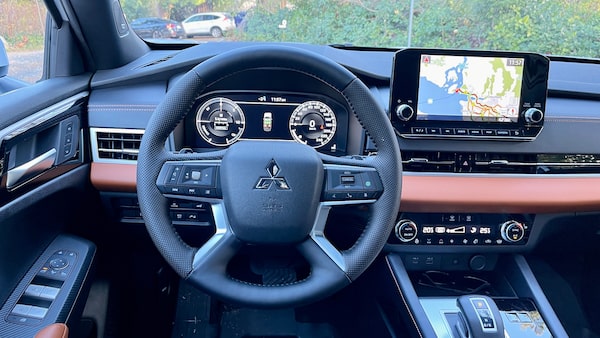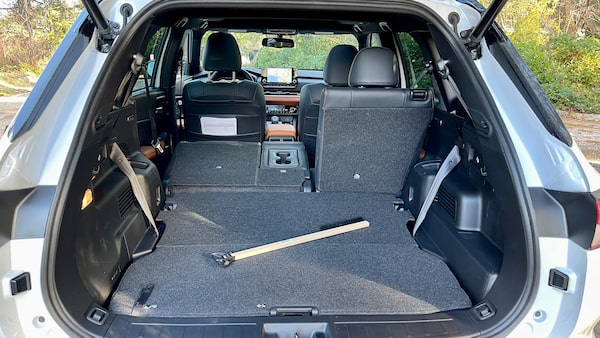
2023 Mitsubishi Outlander PHEV.Mark Richardson/The Globe and Mail
The Mitsubishi Outlander was introduced in 2013 as a plug-in hybrid electric vehicle (PHEV), and a decade later, pretty much everything has finally been tweaked and boosted for its second generation. It had to be – it was well short of the abilities of its current competition. Now it’s caught up.
The vehicle itself is a little larger, with three rows of seats to carry seven people. It has more powerful motors, a bigger battery and a heat pump that helps provide more electric range. It has seven driving modes and new features, including Level 3 charging, a 1,500-watt outlet for powering electrical equipment, and one-pedal driving ability, which is usually only found on fully electric cars. On paper, it sounds terrific.
I watched the company’s enthusiastic presentation, which outlined how the body is now more rigid and the suspension is tuned for a smoother, less rocking-and-rolling drive. It told how the electric motor on the rear axle is more powerful than the one on the front, creating an improved balance. Then I set out through some rare Vancouver snow to climb Cypress Mountain and experience the new compact SUV for myself.
The second-generation Outlander PHEV proved itself to be a pleasant, capable and competitive vehicle, but it is not the second coming of the EV – just the second coming of the Outlander.
It can be set to drive in all-electric mode and claims an electric range of 61 kilometres, up from its previous 39 kilometres, which is now about the same as the four other “affordable” compact SUV PHEVs on the market. It makes a total of 248 horsepower, which is more than the Ford but slightly less than the 261 horsepower Hyundai and Kia, and a lot less than the 302 horsepower Toyota.
It has Level 3 charging, though the onboard charger is fairly mild at 50 kilowatts – good luck holding up the queue of EVs at the public charge station if you’re taking half-an-hour to add 50 kilometres to your optional range. In practice, you’ll always plug in at home, where the Level 2 charging is rated at 3.5 kilowatts and the same charge will take about six hours.

Mitsubishi's Outlander PHEV has a 2.4-litre inline four-cylinder engine and an electric range of 61 kilometres.Mark Richardson/The Globe and Mail
The whole point of a plug-in hybrid is that if you recharge at home or your workplace, you’ll probably only ever use the electric motors for your daily commuting (provided the temperature doesn’t drop too far below freezing), but you can drive as far as you like with your gas engine when the need arises. If you’re trying to justify using a Level 3 charger to EV drivers waiting in line, when you can just top up your gas tank like a traditional driver, then that conversation is going to get ugly.
What does the Outlander PHEV have that its competition does not? Well, the “innovative pedal” is standard in all four trim levels, but it is not a true “one-pedal” feature, where the car slows significantly with regenerative braking when the throttle pedal is eased back, like a golf cart. You must use the brake pedal to come to a complete stop, but you can adjust the level of regenerative slowing-down using paddles on the wheel. This is a nice feature that’s akin to gearing down for a corner, or approaching a stop.
This is also the only compact SUV PHEV to offer seven-passenger seating, just as the gas-powered Outlander has done for a couple of years now. That’s a creative third-row, however, perched over the rear axle with its attached motor and inverter, so it’s pretty cramped back there. In the words of Kentaro Honda, Mitsubishi’s chief vehicle engineer for the segment, “the seat, honestly speaking, is not so roomy, but it’s good for kids or short passengers.” Some other countries, like Australia, offer Outlander PHEVs with no third row, just a large cargo area, but Canada has no such option – the split-seat folds beneath the floor and you must buy it whether you want it or not.
I liked the overall comfort of the Outlander PHEV and I appreciated that it never got stuck in the deep snow. Soon after driving away, however, I noticed a high-pitched motor whine that seemed to come from beneath the hood under power. It was noticeable enough to be annoying, at least at first, and my passenger commented on it too. It seemed to fade through the day but never quite disappeared. Other test drivers, in other cars, agreed with me that they’d noticed this.
I asked Mr. Honda what the noise might be. He suggested either the generator motor or the heat pump, and because it faded through the day, it’s more likely to have been the latter. You’d probably get used to it, but if not, just crank up the radio. There’s always a solution.

The split second- and third-row seats add versatility to the cargo space.Mark Richardson/The Globe and Mail
Tech specs
- Base price/as tested: $46,538 / $57,048, plus $1,900 Freight and pre-delivery inspection
- Engine: 2.4-litre inline four-cylinder with twin AC motors; 20 kilowatt-hour battery
- Transmission/Drive: continuously variable transmission / all-wheel drive
- Fuel economy: Gasoline (litres per 100 kilometres): 9.2 City, 8.7 Highway, 9 Combined; Electric (litres equivalent per 100 kilometres): 3.6
- Alternatives: Toyota RAV4 Prime, Hyundai Tucson and Santa Fe PHEVs, Kia Sportage and Sorento PHEVs, Ford Escape PHEV
Looks
It looks great to my eye – no polarizing grille or spindly features – with nine colour options, and 20-inch wheels available from the mid-grade and up.
Interior

The cabin is nicely put together with quality materials.Mark Richardson/The Globe and Mail
The cabin is nicely put together with quality materials, though the two-tone “semi-aniline leather” of the test car in the photos is only available with the top trim – all other trims are a monochromatic black or grey.
There’s plenty of room for five people, with headroom to spare in the two front rows. If the third row is folded down, however, this all changes: both the front and second row must be pushed forward to create minimal leg-room in the very back. At least the rows are split, so only one side or the other needs to be inconvenienced if there are six-or-fewer people in the cabin.
The top-end tester included massage seats in the front row. In reality, these are air pockets inside the seat backs that expand and contract to relieve pressure, and are quite pleasant, but they don’t knead and pummel as a masseuse might. Even so, it’s only an extra $700 for the higher grade and that includes the two-tone leather which is worth the cost alone.
Performance
Quick enough, but not overly so. Turn the drive-mode dial to “Power” and the Outlander PHEV will sprint to 100 kilometres an hour in about eight seconds. That’s two seconds quicker than the old Outlander, but slower than most electric vehicles. You won’t be embarrassed by many compact SUVs, however.
The Outlander handles well through corners and is pleasant to drive. Its gasoline engine is a bit thirsty for fuel, but if you use the electric motors as often as possible, you may hardly notice the cost of gas.
Technology
It’s surprisingly well equipped, with blind-spot warning, lane departure warning and adaptive cruise control in the most basic model. You even get the 1,500-watt outlet in the base vehicle – good for kettles and hair dryers. Go up through the grades and there’s more, of course, including lane-keeping assistance, headlight levelling and a head-up display that’s clear to read through polarized sunglasses.
Cargo

The Outlander PHEV has 1,875 litres of cargo space when all the seats are folded flat.Mark Richardson/The Globe and Mail
The split second- and third-row seats add versatility to the cargo space. There’s 362 litres of room behind the third row and up to 1,875 litres when all the seats are folded flat. There’s no spare tire, however.
The verdict
The new Outlander PHEV is not groundbreaking, but it is finally a worthy competitor among the other vehicles in its segment. The good news is that if you want an up-to-date compact plug-in SUV, Mitsubishi can probably sell you one, anywhere in Canada, earlier than any of the other manufacturers.
The writer was a guest of the auto maker. Content was not subject to approval.
Shopping for a new car? Check out the new Globe Drive Build and Price Tool to see the latest discounts, rebates and rates on new cars, trucks and SUVs. Click here to get your price.